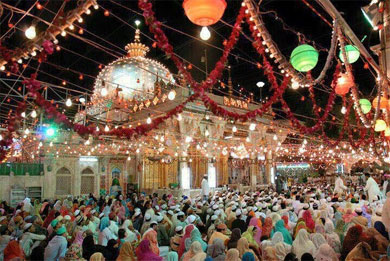By Taimur Shamil
02/05/2016

Dargah Sharif of Hazrat Khwaja Moinuddin Chishti Gharib Nawaz (1141 AD-1236 AD) the emancipator of the poor, the founder of the Chishti order of Sufism in South Asia
The annual commemorative festival, or urs, of Hazrat Khwaja Moinuddin Chishti Gharib Nawaz (1141 AD-1236 AD), the emancipator of the poor, the founder of the Chishti order of Sufism in South Asia takes place in Ajmer, India. Every year hundreds of devotees from around the world throng to this Sufi gathering. The festival starts with traditional religious supplications and recitation of the Quran, followed by renditions of Qawwali, the devotional Sufi music that has flourished and thrived in South Asia through the ages. The Chishti Sufis, known for their vibrant and aesthetic dispositions, introduced this genre of music, imbued with a careful precision of ragas and poetry. To Sufis, it connects human beings with the eternal truth; the almighty.
Qawwali is derived from the word Qaul which means literally, 'word' or 'words of wisdom', and is a relatively recent coinage by the Sufis of the subcontinent. The early Sufis of the 11th and 12th century called it Sam'aa, in the Middle East. Sam'aa, traditionally, was a Sufi gathering which usually comprised nay, daff, and Sarangi as musical instruments. Sufis would gather in this Sam'aa to chant God's names, clap and sing holy couplets and reprise Quranic verses. Almost all the Sufi orders in the world group together for Sam'aa but the tradition in South Asia has its own flavour. The Chishti Sufis of India, in particular, stand out for their literary, poetic and musical traditions.
Khwaja Moinuddin Chishti is said to have had an emphatic affinity for Sam'aa. The Sufis who followed him later in his order kept this tradition alive, but it was not until Nizamuddin Auliya of Delhi (1238 AD- 1325 AD) that Qawwali reached its zenith. It is a generally accepted fact that Amir Khusro, the disciple of Nizamuddin Auliya (1253 AD - 1325 AD) promoted Qawwali in its latest form. Khusro was a Sufi, a courtier, a musician and a poet who wrote in both Hindi and Persian.
Scholars are of the view that like other Sufi masters of the Chishti order Nizamuddin Auliya was also fond of Sam'aa and Qawwali. Khusro, who was also the leading Qawwal, experimented with different words, techniques and languages and ended up with great innovations in Qawwali, in musical instruments like Sitar and Tabla and many other composite musical methods. Khusro’s originations in the field of music and poetry and Nizamuddin Auliya's highest mystical treaties, combined to make Delhi the hub of spirituality and Sufi learning.
Many other Sufi orders that gradually evolved in the 16th and 17th century--like Shattariyyah and Naqshbandiyyah--also brought variety to this genre but the transcendent fascination that the Chishti's Qawwali had for the public, was unparalleled. Chishti Sufis like Abdul Quddus Gangohi and Shaikh Baha'uddin added new mystic flavours to Qawwali and musical techniques. Shaikh Bahauddin of Delhi enriched the classical musical traditions of Khusro to a great extent.
It is said that people from as far as the Deccan came to learn musical techniques and qawwali from the Shaikh. Later, he introduced new Zikris( chants) in veneration of the fourth Caliph Ali and admiration of Khwaja Moinuddin in which he combined the style of Amir Khusraw and classical Indian tunes or ragas.
Hindi or Hindavi, as compared to Persian, was popular in all Sufi circles, especially near Delhi. Saiyid Gesu Daraz, a renowned Chishti Sufi master believed that no language was as effective as Hindavi. He believed that Hindavi music was subtle and elegant, penetrated deeply into the heart and stirred humility and placidity in one's soul.
Metaphors and symbols play an important role in the creation of Qawwali. Many Sufis of the later 19th and 20th centuries used Hindu religious symbols like Radha and Krishna, Hari, Ram Leela, to evoke religious sentiments at Sufi gatherings. Later, the spiritual works of Hindu and Sikh saints were also included and sung in Qawwali. All those verses and works which had the connotation of "oneness of reality" and "unity with the supreme being" were frequently used. The verses and couplets of Bhagat Kabir, Guru Nanak, Tulsi Das were often sung in these Sufi gatherings.
The modern trends in Qawwali reflect changing times. From Bollywood movies to Sufi shrines, Qawwali is sung ubiquitously because of its universal appeal and the way everyone can relate to it. Many singers have specialized in singing in the Sufi style. Among the Qawwals who have earned international fame are Ustad Nusrat Fateh Ali Khan, Sabri brothers, Aziz Mian, Munshi Raziuddin. Recently Abu Muhammad/ Fareed Ayyaz, Rizwan and Muazzam have earned considerable name in this genre. Abida Parveen, while she is not technically a Qawwal is an outstanding female exponent of Sufi singing.
The Qawwali at the Urs of Khwaja Ghareeb Nawaz Moinuddin Chishti encompasses many expressions. It takes shades from the seeker's inadequacies in the search for truth to the ultimate discovery and consequent celebration of success. This message of unity makes qawwali more relevant than ever.
Source: huffingtonpost.in/taimur-shamil/qawali-the-sufi-devotiona_b_9777006.html?utm_hp_ref=india

No comments:
Post a Comment